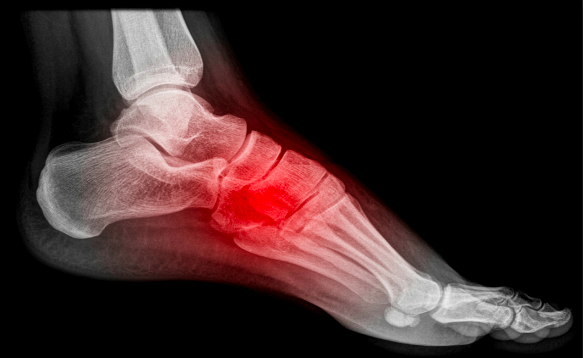 Stress fractures are small, hairline cracks within a bone. Unlike standard fractures which typically occur from trauma or injury, stress
fractures develop over time through repetitive stress to a bone. While stress fractures can affect any bone, they are more common in bones
such as the metatarsals (the long bones of the feet) and the tibia (shin bone).
Stress fractures are small, hairline cracks within a bone. Unlike standard fractures which typically occur from trauma or injury, stress
fractures develop over time through repetitive stress to a bone. While stress fractures can affect any bone, they are more common in bones
such as the metatarsals (the long bones of the feet) and the tibia (shin bone).
When high-impact forces are repetitively put on a bone, tiny cracks may form. Over time and with more stress to the bone, these cracks can
continue to grow and begin to cause painful symptoms. This is a stress fracture. Any activity or condition that results in pressure and
heavy loads on a bone can lead to the development of a stress fracture. This includes:
Because the damage from stress fractures build up over time, the pain can come on gradually without being linked to a certain incident or event. Symptoms at the fracture site can include:
The first part of treatment focuses on relieving the painful symptoms. This can be achieved using the PRICE principles (protection, rest, ice, compression, elevation). The focus of treatment is then to facilitate the healing and repair of the fracture and address the cause to reduce the risk of it happening again. This may include:
Your podiatrist will create a tailored management plan based on the cause of your stress fracture, your symptoms and your regular activities.

If you’re unsure whether you should wear walking or running shoes when exercising, this article is for you.
We explain the differences between walking and running shoes and how to determine which one is best for your feet. When it comes to buying a new pair of shoes, most people walk into a store expecting to just “find something comfy.” Then, suddenly, you’re asked: Are you looking for
walking shoes or running shoes? And that’s where the confusion begins. Because for many people, the answer isn’t that simple.
You could walk a lot – to work, around the block, chasing after the kids, or while catching up with friends. You could have also just joined
a gym or registered for the Couch to 5km. Or you could be a walker who just wants the option to go for a run if the mood strikes. So, which
shoe do you pick?

Discover why foot health is so important as we age and how Perform Podiatry supports seniors in staying mobile, independent, and pain-free. From diabetic care to personalised treatment plans, we’re here to help keep your feet happy and healthy, every step of the way.

Discover how Class IV Laser Therapy at Perform Podiatry offers powerful, drug-free relief for foot and ankle pain. Backed by science, this advanced treatment helps you heal faster and move better, without the need for surgery or medication.
Keeping your family on their feet and helping them to walk, run, play and exceed their goals is why we love getting up in the morning.
Ground Floor, One Health Building
122 Remuera Rd, Remuera
Auckland 1050, New Zealand
| MON - FRI | 7:30am – 6:30pm |
| SAT | 8:30am – 4:30pm |
| SUN | Some availability |
Make an Appointment
Online Schedule
Our virtual receptionist is available 24/7 to help with general questions, booking requests, and clinic information, even when our team is busy, or it's after hours.
Whether you're calling us or using our website, you'll get fast assistance any time of day. And if your query needs a personal touch, a member of our team will follow up as soon as possible.